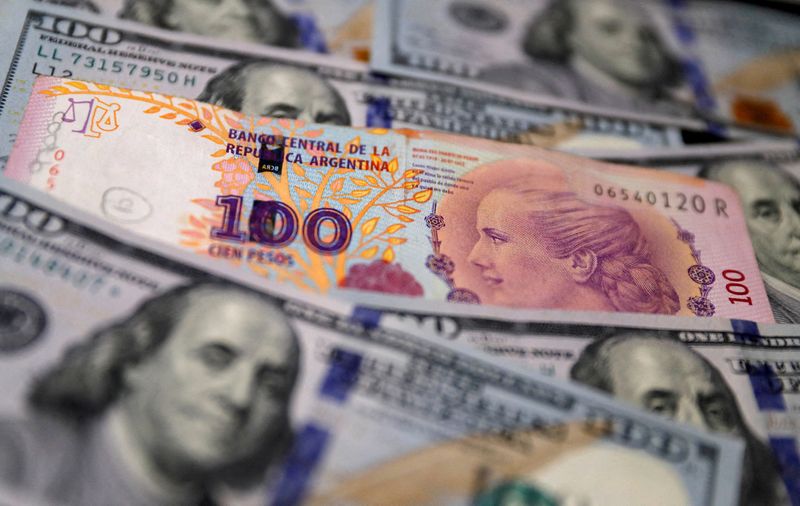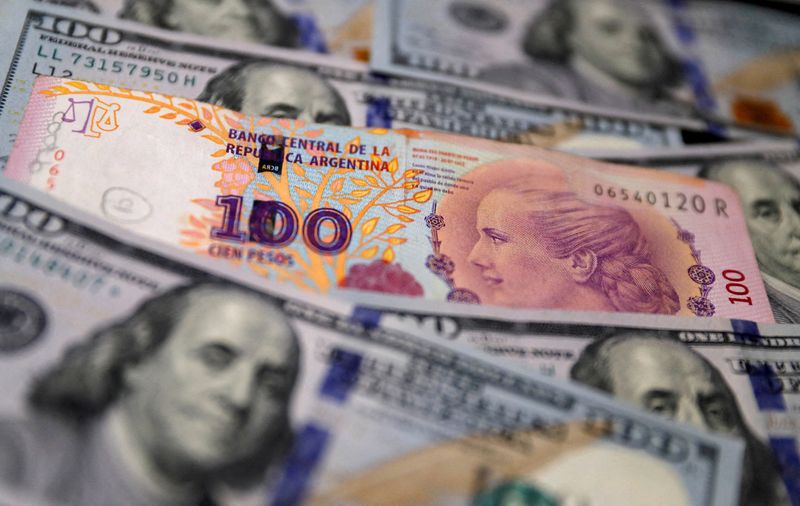Forex
Argentina, in dollar love affair, agonizes over divorcing the peso


© Reuters. FILE PHOTO: A one hundred Argentine peso bill sits on top of several one hundred U.S. dollar bills in this illustration picture taken October 17, 2022. REUTERS/Agustin Marcarian/Illustration/File Photo
2/3
By Marc Jones, Eliana Raszewski and Rodrigo Campos
LONDON/BUENOS AIRES/NEW YORK (Reuters) – María Barro, a 65-year-old domestic worker in Buenos Aires, buys a few dollars each month with her peso salary, a hedge against Argentina’s persistent inflation now running at over 100% and a steady devaluation of the little-loved local peso.
The peso currency is now in the crosshairs of the country’s dark horse presidential front-runner, libertarian radical Javier Milei, who has pledged to eventually scrap the central bank and dollarize the economy, Latin America’s third largest.
Milei – facing a tight three-way battle with traditional political candidates on the right and left ahead of an Oct. 22 vote – says savers like Barro underscore why Argentina should shed the peso.
“I try to buy dollars, no matter how little,” said Barro, who started to buy greenbacks on parallel markets in 2022 when 2,000 pesos got her $10. Now it would get her $2.70. “Pesos go like water and every day they are worth less.”
Barro supports the idea of a dollarized economy in theory, but says she doesn’t like Milei’s aggressive style, which involves regular expletive-laced tirades against rivals and even the Pope. She is still undecided about her vote.
Milei’s dollarization plan has sharply divided opinion: his backers argue it is the solution to inflation near 115% while detractors say it an impractical idea that would sacrifice the country’s ability to set interest rates, control how much money is in circulation and serve as the lender of last resort.
“The argument for dollarization is that there is no price stability and the independence of the central bank is an illusion,” said Juan Napoli, a Senate candidate for Milei’s Liberty Advances party.
Napoli admitted Argentina was not yet ready for full dollarization. Milei and advisers have talked about a nine-month to two-year time frame.
“It requires a great political agreement between us and also having sufficient reserves,” Napoli said. The central bank’s current net foreign currency reserves are deep in negative territory. “It will take a while, it won’t happen immediately.”
‘ABSOLUTE LAST RESORT’
Dollarization has been tried elsewhere, usually either replacing the local currency with dollars at a set exchange rate, or intervening in the markets to ‘peg’ the local tender to the dollar. The central bank loses its monetary policy setting role, but often is kept to handle technical and administrative tasks such as reserves management and payment systems.
Argentina pegged its peso to the dollar in 1991 under the neo-liberal economic policies of President Carlos Menem and even debated full dollarization. However, it was forced to undo the peg a decade later as a major economic crisis and run on the peso sparked riots and saw the currency board collapse.
Bolivia has a dollar peg, Venezuela has a quasi-dollar driven economy, while Ecuador, El Salvador and Panama all officially use the dollar. Zimbabwe dollarized and then abandoned it, though economists estimate that 80% of its local economy remains in dollars.
Argentina’s $650 billion economy, though, would be by far the largest dollarization experiment, were it to happen. The country is a major global exporter of soy, corn and beef, has one of the world’s largest reserves of electric battery metal lithium and huge shale gas and oil reserves in Vaca Muerta.
Many Argentines themselves are unconvinced, fearing loss of economic independence and over-reliance on the United States. Polls in recent months show more people oppose the idea, though some new surveys suggest support is rising as inflation peaks.
“I don’t know what’s the solution, but I disagree with dollarization,” said Martina Rivero, 25, who works at a baby clothes store in Buenos Aires’ trendy Palermo district.
Milei’s presidential rivals, Economy Minister Sergio Massa and conservative ex-security minister Patricia Bullrich, have both shot down the idea of dollarization as impractical.
The government also has a $44 billion loan program with the International Monetary Fund (IMF), which means economic policy making often comes with strings attached. Milei spoke with the IMF in August, with dollarization part of the discussion.
While the IMF has not commented on the plan, many experts see it as a drastic move.
“To me, it is an absolute last resort,” said Olivier Blanchard, a former IMF chief economist and now an academic. “It’s very costly to give up flexibility of the exchange rate.”
DOLLARS UNDER THE MATTRESS
Mark Sobel, a veteran U.S. Treasury official now at the OMFIF policy think tank in the United States, said dollarization meant authorities would lose the ability to act as a lender of last resort, which would “heighten the vulnerability of the financial system.”
Instead, he said the central bank needed to stop printing money to fund the Treasury and cut its fiscal deficit.
For many, the issue is that Argentine savers’ love of the dollar is almost impossible to undo. Many were burnt when the government confiscated, froze or forcibly converted deposits in 1989 and 2002 in what is locally known as the “corralitos”. Trust has been hard to win back since.
A widely cited bit of official data suggests that Argentines have as much as $371 billion in dollar assets, much of it outside the local financial system, reflecting decades of people putting non-peso savings out of the government’s reach, weakening the domestic economy.
“Savings now get stuffed in the mattress or at best to invest in another country. So the link between savings and investment in Argentina is broken,” said Facundo Martinez Maino, an economist who worked on Bullrich’s economic plan.
That plan supports formalizing a “bi-monetary” system the country already has informally to bring those squirreled-away dollars back into the formal financial system.
“Dollarization is a huge fantasy and it is a big campaign lie,” said Martinez Maino. “Not even the most fanatical, fervent supporter of dollarization in Argentina can argue for it seriously right now. For a simple reason. Argentina has no reserves.”
In a recent public war of words, Milei said Bullrich’s plans were “cowardly, lukewarm, and would end in hyperinflation and bloody dollarization”.
Supporters of dollarization say it would boost the country’s risk premium – good news for long-suffering investors – and should be feasible by first converting just physical cash.
Argentina’s monetary base of cash in circulation and deposits is 6.15 trillion pesos, around $17.5 billion at the official exchange, central bank data show. At widely-used parallel exchange rates, however, that’s only $8.4 billion.
“It is already a principle that Argentines practice on a daily basis. They keep huge amounts of dollars in their houses,” said Riccardo Grassi at Mangart Advisors, a Switzerland-based hedge fund involved in Argentina’s huge 2020 debt restructuring.
“Dollarization is a rational idea,” said Grassi.
‘LACK OF CONFIDENCE IN THE PESO’
On the streets of downtown Buenos Aires, there are signs everywhere with dollar prices alongside those in pesos. Some things – houses or cars – are closely linked to the dollar already and expensive, while other prices are held artificially low by subsidies, including utilities, fuel pump prices and public transport.
Some local firms already opt to pay salaries, at least in part, in dollars. Some 20% of local bank deposits are dollarized, although that doesn’t catch greenbacks stashed outside the banking system.
Claudio Loser, a former IMF director for the Western Hemisphere, said dollarizing fully, though, would be a “terrible shock” to the economy as holders of pesos would exchange them at a very high rate, diluting savings. Wealthier people with stashed dollars would have more protection.
Back on the streets of Buenos Aires, 18-year-old student Nicolas Ventrice was in favor of dollarization and Milei, though he admitted he didn’t really understand what it involved.
“What motivates young people the most is the dollarization of the country,” he said. “(Milei) explains it more or less, though I never fully understand how he is going to do it… all that stuff is a bit confusing.”

 Forex3 years ago
Forex3 years agoForex Today: the dollar is gaining strength amid gloomy sentiment at the start of the Fed’s week

 Forex3 years ago
Forex3 years agoUnbiased review of Pocket Option broker

 Forex3 years ago
Forex3 years agoDollar to pound sterling exchange rate today: Pound plummeted to its lowest since 1985

 Forex3 years ago
Forex3 years agoHow is the Australian dollar doing today?

 Cryptocurrency3 years ago
Cryptocurrency3 years agoWhat happened in the crypto market – current events today

 World3 years ago
World3 years agoWhy are modern video games an art form?

 Commodities3 years ago
Commodities3 years agoCopper continues to fall in price on expectations of lower demand in China

 Economy3 years ago
Economy3 years agoCrude oil tankers double in price due to EU anti-Russian sanctions

























